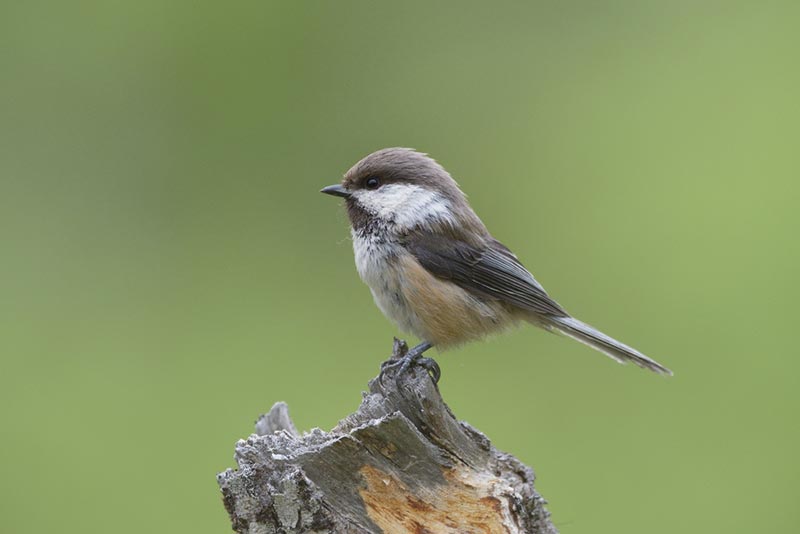Gray-Headed Chickadee: Field Guide, Pictures, Habitat & Info
Last Updated on

The Gray-Headed Chickadeeis a small songbird that is relatively uncommon in the U.S. and its relatively low numbers mean that ornithologists do not know too much about its habits here, so most information is assumed from its European counterpart, known as the Siberian tit.
It is an omnivorous bird that prefers spruce and willow trees for nesting and is rarely seen at backyard feeders because of its remote habitat and low numbers.

Quick Facts about Gray-Headed Chickadees

| Habitat: | Spruce and will trees along streams |
| Diet: | Omnivore |
| Behavior: | Rarely seen |
| Nesting: | Tree cavities up to 15 feet above ground |
| Conservation: | Scarce |
| Scientific name: | Poecile cinctus |
| Lifespan: | 7 years |
Gray-Headed ChickadeeGeneral Description
Very little is known about the Gray-Headed Chickadee in the U.S. because there are only a few reliable sightings of this species each year. However, the Gray-Headed Chickadee is commonly seen in parts of Europe, and U.S. sightings do tell us that it is slightly larger than other chickadees and has a dark gray cap, light brown sides, and white on the cheeks, as well as the distinctive gray head.
Gray-Headed Chickadee Range, Habitat, Behavior, Diet & Nesting
The Gray-Headed Chickadee is rarely found in the U.S. and is considered a highly sought-after prize by keen and professional bird spotters. It is a member of the chickadee family of birds although it is slightly larger and fluffier than most other species. It is believed to be omnivorous and, if it shares the same characteristics as its Siberian cousins, has the following features:
https://www.instagram.com/p/CONU2SHADGh/
Range
The Gray-Headed Chickadee is rarely seen in the U.S. but can be found in small numbers in Alaska and Northwest Canada. It lives in very remote areas, which makes spotting the species difficult, and it is usually found in spruce and willow trees and near streams.
Habitat
Spruces and willows are the bird’s preferred trees. They are rarely if ever, seen in urban or built-up areas.
Behavior
In Eurasian Gray-Headed Chickadee groups, the birds flock together in small grounds to forage for food. They tend to eat from conifers and, as songbirds, they are able to forage on branches and twigs and can sometimes be seen hanging upside down to gather their food. They do sometimes forage on the ground, however.
Diet
Their diet consists mainly of insects and seeds, with the exact food they eat depending on the region they are found in. Where they forage among spruces, they will eat spruce seeds and may eat the pupae and eggs of insects, such as spiders, beetles, flies, and caterpillars.
Nesting
Pairs seem to remain together for the whole year. Their territory can be quite large, and the male chickadee will feed the female until their young are about half-grown. The birds usually build their nests in tree cavities and may use old woodpecker holes.

How to Find Gray-Headed Chickadees: Birdwatching Tips
There are very few sightings of Gray-Headed Chickadees reported in the U.S. or Canada, and keen bird watchers are likely to have to take bush planes or boats to reach their territory. As such, birdwatching tips are scarce.
What to Listen For
The species has a soft trill and they have the “chick-a-dee” call that gives this family of birds its name.
What to Look For
The bird is quite small and has a brown body and darker brown head with white cheeks. The wings are pale, and the sides of the bird are light brown.
Gray-Headed Chickadee Conservation: Is this Bird Threatened?
The Gray-Headed Chickadee is considered extremely rare, although this doesn’t necessarily mean that its numbers are under threat. However, there are some reports that sightings have decreased. It is also reported that numbers in Scandinavia have dropped, although there are no figures given for the species in Russia.

Final Thoughts
Although it is a prized sighting for the keen birdwatcher in the U.S. and Canada, the scarcity and the remote habitat of the Gray-Headed Chickadee means that very little is known about this bird in these countries. More is known of them in parts of Europe, however, so experts can assume some details using this information.
- You may also like: 5 Types of Chickadees (With Pictures)
Featured Image Credit: Michal Pesata, Shutterstock
About the Author Robert Sparks
Robert’s obsession with all things optical started early in life, when his optician father would bring home prototypes for Robert to play with. Nowadays, Robert is dedicated to helping others find the right optics for their needs. His hobbies include astronomy, astrophysics, and model building. Originally from Newark, NJ, he resides in Santa Fe, New Mexico, where the nighttime skies are filled with glittering stars.
Related Articles:
10 Types of Hummingbirds in Arkansas (With Pictures)
8 Types of Hummingbirds in Nebraska (With Pictures)
5 Types of Hummingbirds in Idaho (With Pictures)
3 Types of Hummingbirds in Mississippi (With Pictures)
8 Types of Hummingbirds in Kansas (With Pictures)
5 Types of Hummingbirds in West Virginia (With Pictures)
5 Types of Hummingbirds in Ohio (With Pictures)
Where Do Nuthatches Nest? Nuthatch Nesting Habits Explained
